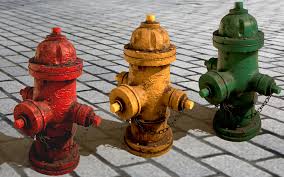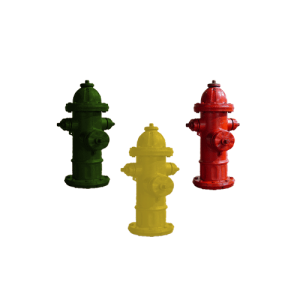Fire hydrant

In big cities, taps or fire hydrants are used for fire safety and to prevent possible fire crises. A fire hydrant, used by firefighters on a fire to extinguish flames, allows firefighters to quickly access your pressurized water system. Firefighters remove one or two nozzles, attach the hose to the nozzles, and turn the valve to get the water flowing. They know how much pressure is available based on the color of the hydrant body and the type of nozzle, allowing them to make quick decisions to prevent disaster and reduce property damage.
What type of hydrant should we install?
People are often familiar with the part of the hydrant that is visible from ground level. But the fire hydrants are several meters underground. For various purposes, there are two types of wet and dry cylindrical hydrants, in addition to the common type of standing pipe hydrants. These have different structures and mechanisms depending on the conditions of the placement environment. Wet cylinder fire hydrants are more common in the South because they don’t have the risk of freezing in the cold winter, while dry cylinder fire hydrants are more common in places where freezing can be a problem.
Types of fire hydrant mechanisms
Wet cylindrical fire hydrant

With a potential useful life of over 100 years when properly maintained, wet cylinder hydrants are an industry standard in areas where freezing is not likely to occur during cold winters. Freezing is because all the mechanical parts of the hydrant are located above the ground. The water main required by the fire hydrant is close to the surface of the ground, making it prone to freezing during the cold seasons of the year. A more fundamental mechanism of wet cylindrical fire hydrants is their longevity. But their weakness is that the water in them freezes easily in cold weather.
Dry cylindrical fire hydrant

Dry cylindrical fire hydrant is available in three different types: slide-gate, toggle and compression mechanism. In dry cylindrical hydrants, the hydrant valve is much lower than the ground level at the base of the hydrant. Since the entire water system is underground, no water remains in the hydrant system after use. This greatly reduces the risk of frostbite. Part of the dry cylinder hydrant maintenance cycle is to check for water at the base of the hydrant. They usually check the presence or absence of moisture by using the line and mark placed in the hydrant. The presence of moisture can be a sign that the drain valve of the water faucet is not working properly and it is left open to freeze to be replaced after freezing.
Fire hydrant colors
Fire hydrants often have a wide range of different colors, some of which are meaningful and some of which are not. Generally, the color of the fire hydrant body is a matter of choice, but it is often red, yellow or green to make it more visible from a distance. This helps firefighters find the hydrant quickly in an emergency. In addition, some municipalities use a color scheme that provides information about the amount of water pressure available at each faucet.

The color of the nozzle caps on the fire hydrant has different meanings that the rescue or emergency forces and service workers are often familiar with. In general, red is only for special operations, such as the fire service. A yellow color indicates that the faucet is on a water main that may be under high pressure. While the color white indicates that the faucet is in the service of water equipment and services, it is not necessarily in a main water main. The purple color is usually used to supply non-potable water according to international standards, such as untreated water that can come from a lake or pond.
Standing tubular fire hydrant

Standing pipe fire hydrant for firefighters Although it has a different function from traditional hydrants, this type of hydrant is also a suitable tool for firefighters to deal with fire. Typically, in the interior locations of large buildings, this type of hydrant serves as a suitable alternative to sprinkler systems. These pipes allow firefighters to distribute water to a specific part of the building. This allows people who cannot escape from the building to put out the fire on their own. A standing pipe hydrant is an essential tool for firefighters, especially in large structures where firefighters need a long hose to fight the fire.
Choosing the right fire hydrant for your water facility requires knowledge, planning and experience. By consulting experts in a well-equipped firefighting equipment store, you can be more confident in your choice and choose the best option according to your environmental conditions. HyperFire firefighting equipment store can help you a lot in this field.
دیدگاه خود را با ما در میان بگذارید














